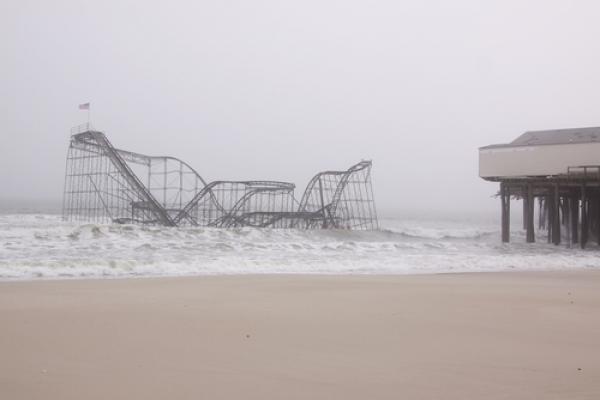This week marks the one-year anniversary of Hurricane Sandy, the superstorm that decimated metropolitan areas of the East Coast last fall.
Damage from the storm resulted in more than 100 fatalities, with an estimated loss of $65 billion. Thousands of homes were lost, and millions were without power for days. Thousands of flights were canceled along the eastern seaboard, and multiple public transit services were suspended, including Amtrak and New York City’s bus and subway system. Even the U.S. economic structure ground to a halt, with NASDAQ and the New York Stock Exchange closing to buckle down before the deluge.
One year later, we reflect on reconstruction efforts post-Sandy. We also pause to assess the role of climate change, exacerbated by human actions, in the creation and severity of the storm.
To understand the impact of climate change in last October’s superstorm, the first place to look is in the seawater off the Atlantic coast. Ocean temperatures have been growing warmer. When Sandy hit, the surface waters along the 500-mile coastline from southern states to Canada were 5°F above the normal average, with climate change contributing up to 1°F in making the waters unnaturally warm.
In storm formation, the ability of the atmosphere to hold moisture increases by 4 percent for every 1°F rise in water temperature. So, Sandy was able to gather up more moisture given the warmer conditions of the sea, and thus had greater potential to unleash a powerful storm with exponentially more rainfall.
Climate change has increased the probability of intense hurricanes and strong coastal storms, and human action is the most significant contributing agent in climate change. The excess of human-made carbon pollution causes heat-trapping gases to remain in the atmosphere. Climatological effects of this include increased global temperatures, warmer and moister atmospheric conditions over oceans, and a rise in sea level due to melting glaciers and land ice. Scientists warn that warmer oceans and increased moisture in the atmosphere contribute to storm intensity, and that rising sea levels threaten coastal areas with and without the impact of storms.
If we do not make effort to reverse or rectify the deleterious effects of climate change, we inevitably usher in a new normal for extreme weather events. After Sandy hit, Rep. Henry Waxman (D-Calif.) urged Congress to hold a hearing on the connection between the superstorm and climate change. He also asked several times throughout the year for hearings in response to devastating wildfires that plagued the West. Each time, Republicans were dismissive of his requests. Rather than constructive dialogue around the reality of climate change, Republicans seem more keen on seeking to discredit scientists’ findings.
Historically, climate adaptation — that is, any infrastructure and behavioral changes that make cities and towns more resilient to the potential impacts of climate change — has been a low-funding priority. The federal government’s gridlock and reluctance to invest in preemptive structures to reduce negative impacts of climate change have angered many citizens. The idea of a levee system in Staten Island neighborhoods that were flooded during Superstorm Sandy seemed a hopeful step in the right direction. However, residents resented the idea of being taxed for its creation, feeling it is the authorities’ job to protect the safety of people.
The levee system idea for Staten Island actually arose in 2000 from the Army Corps of Engineers. After initial planning, however, budget shortfalls delayed the study, which remained unfunded for two years.
Likewise, New York City Mayor Michael Bloomberg has proposed projects like a surge barrier, new dunes, and removable floodwalls around the city that would protect residents from storms like Sandy. The estimated cost is $20 billion. The mayor admitted it will not be enough, and it is unclear where the funding will come from.
Given Congress’ aversion to spending on such efforts, the lack of political will to undertake preventative infrastructure development is not surprising. Sobering, however, is the D+ rating of national infrastructure by the American Society of Civil Engineers.
While no one seems to want to pay for social protection from extreme weather events, a new Ceres report documents a “growing taxpayer burden from climate inaction.” The findings highlight the rising costs to Americans for federal programs that provide flood insurance, crop insurance, wildfire protection, and disaster relief. The extreme weather events our country is increasingly experiencing have a direct correlation to climate change, and citizens are shouldering the burden. Costs will continue to rise, the report warns, unless government programs are “reformed to encourage less-risky, more-resilient practices.” Ceres released the report on the one-year anniversary of Sandy.
Of course, we can acknowledge that multiple climatological variables contributed to create the conditions for “the perfect storm.” But the presence of human-induced climate change is a new force of nature to be reckoned with, and, as the havoc of Hurricane Sandy shows us, one that cannot be ignored.
Anna Hall is campaigns assistant for Sojourners.
Image: Roller coaster off the coast of Seaside Heights, N.J., after Hurricane Sandy. Glynnis Jones / Shutterstock.com
Got something to say about what you're reading? We value your feedback!
